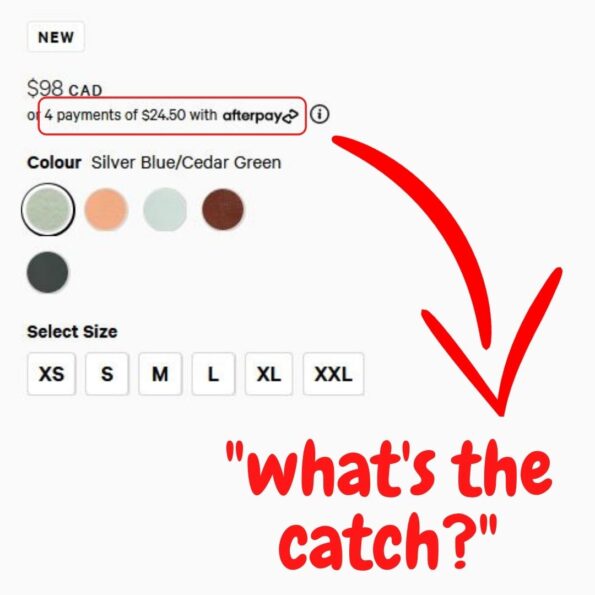It’s 2022, and we’re arguably more comfortable buying from within the walls of our own home than having to get dressed and go to the mall. As we’ve stuffed our virtual carts with items we need (or don’t), most of us have likely seen the options at the checkout to pay the balance or “4 interest-free payments.” Sounds great, but what’s the catch?
What you’re seeing is known as a “buy now, pay later” (BNPL) service and the idea isn’t necessarily new. The concept can be dated back to the 80’s when layaway or no-money-down plans were popular. Fast forward to the 21st century and tech companies have been able to modernize the once outdated payment plan.

“Interest-free payments sound great, but how do these companies then make money?”
Great question!
These companies make money by charging the merchant a fee (~6% of the sale) rather than to the consumer which is why you’re able to see it as “interest-free.” For example, Lululemon is selling their sweats for $100 online and you see the option of 4 interest-free payments of $25 using PAY L8R (not a real company, but not a bad name for one). Once you select the installment payment option, PAY L8R will pay Lululemon $94 ($100 minus the 6% charge) for the item and Lululemon will then ship you your sweats. Awesome, but you now owe PAY L8R. Typically, you pay them the first installment at checkout and the rest over a set number of weeks until you’ve paid off your debt, assuming everything goes perfectly.


As a Wealth Mentor, what are some potential issues I can see arising for us consumers?
- We’re likely to spend the money that should be allocated towards paying off the remaining debt.
- Though one can argue that you can invest the rest, usually you must pay off the loan in a matter of weeks. It wouldn’t be fiscally wise to invest in that short time frame and having it in a high-interest savings account might only make you a few cents.
- You’re more likely to spend more if you know that you can spread the cost over time. Studies have shown that though there are higher transaction fees for merchants offering BNPL services, they make more per sale.
- It can be problematic if you are wanting to return any items, especially if you’re in the middle of your payment schedule.
- Late fees, interest charges, and missed payments can result in ultimately paying more for the same item.
- Depending on the company, they might report payments to a credit bureau which could impact your credit score (which might be good or bad, depending on your situation).*
*Each provider has its own set of terms and conditions, so it’s important you read them before considering using one.

Takeaway
All things considered, if you don’t have the money to buy what’s in front of you today, regardless of the payment method, you simply shouldn’t be buying it. I would reserve BNPL services for genuine emergencies should something come up that you need with the knowledge that you will have a source of funds coming in soon. Even then, I would use a credit card first since some providers include benefits, such as extended warranty, that wouldn’t qualify if using BNPL services.
If everything works out perfectly, the best-case scenario is that you walk away with the item having paid for it over several weeks. Are BNPL services bad? Not necessarily, but the upside simply doesn’t outweigh the potential consequences.
“But Josue, I want that $100 pair of sweats really bad and can’t afford it right now.”

Make your own payment schedule. Start today by setting aside the first of four bi-weekly payments into a separate account and by the end of six weeks, you’ll have enough to buy them knowing that you put in the arduous work to save up for them. After all your hard work, you can use your sweats for what they were intended for – kickin’ it on the couch watching a movie with an abundance of snacks.
Your Friend,
Josue Dubon
“Everytime you spend money, you are casting a vote for the kind of world you want.”
Anne Lappe
